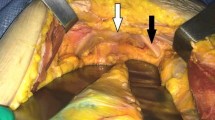Abstract
Aim: One of the complications of abdominal surgical procedures is incisional hernia. This complication is encountered in different rates due to the surgical technique, type of urinary diversion preferred, and whether the patient has additional risk factors or not. Patients and methods: In this study, 145 patients who had undergone urinary diversions in our clinic were evaluated between the years 1989 and 2002. Of those, 17 were treated by Mainz pouch type II urinary diversion, 47 by Indiana type urinary diversion and 81 patients were treated by orthotopic urinary diversions. Results: Incisional hernia did not occur in any of the patients who had undergone Mainz pouch type II and Indiana type urinary diversions. Eleven of 145 patients (7.5%) who had undergone urinary diversions developed incisional hernia. All of these incisional hernia occurred in patients who had undergone orthotopic type urinary diversion. These incisional hernias occurred within the first postoperative year (2–8 months). Conclusions: We believe that increased intraabdominal pressure for micturition is the predisposing factor for the development of incisional hernias. Furthermore, the patients must avoid from sudden increase of intraabdominal pressure such as suddenly, strong valsalva maneuver during voiding. And we believe usefully press doing from the outside to abdomen during voiding (crede maneuver).
Similar content being viewed by others
References
Santora TA, Roslyn JJ. Incisional hernia. In: Ira M, Rutkow MPH, eds. Hernia Surgery. Surgical Clinics of North America, Philadelphia: Saunders, 1993: Vol. 73(3). 557–570.
M Deitel R Alhindawi M Yamen et al. (1990) ArticleTitleDexon plus versus Maxon fascial closure in morbid obesity: a prospective randomized comparison Can J Surg 33 IssueID4 302–304
M Mudge LE Hughes (1985) ArticleTitleIncisional hernia: a 10 year prospective study of incidence and attitudes Br J Surg 72 IssueID1 70–71 Occurrence Handle1:STN:280:BiqD1MfktlA%3D Occurrence Handle3155634
AV Pollock M Evans (1989) ArticleTitleEarly prediction of late incisional hernias Br J Surg 76 IssueID9 953–954
TE Bucknall PJ Cox H Ellis (1982) ArticleTitleBurst abdomen and incisional hernia. A prospective study of 1129 major laparotomies Br Med J (Clin Res Ed) 27 931–933
JP Houck EB Rypins IJ Sarfeh et al. (1989) ArticleTitleRepair of incisional hernia Surg Gynecol Obstet 169 IssueID5 397–399
H Ellis PD Coleridge-Smith AD Joyce (1984) ArticleTitleAbdominal incisions: vertical or transverse? Postgrad Med J 60 IssueID704 407–410
DM Douglas (1952) ArticleTitleThe healing of aponeurotic incisions Br J Surg 40 79–84
JD Urschel PG Scott HTG Williams (1988) ArticleTitleEtiology of late developing incisional hernias–The possible role of mech-anical stress Med Hypoth 25 31–34
Author information
Authors and Affiliations
Rights and permissions
About this article
Cite this article
Resim, S., Ihsan Tasci, A. & Sahinkanat, T. Incisional hernia: A possible complication after the orthotopic urinary diversion?. Int Urol Nephrol 36, 519–522 (2004). https://doi.org/10.1007/s11255-004-0843-z
Issue Date:
DOI: https://doi.org/10.1007/s11255-004-0843-z




